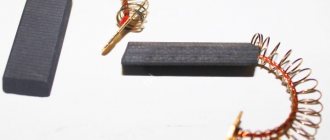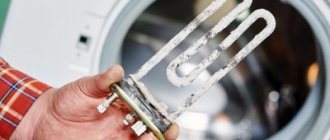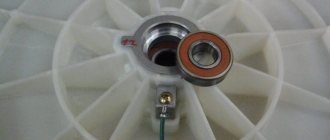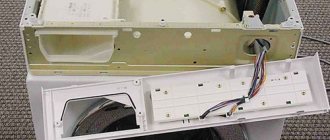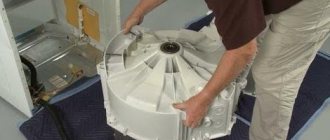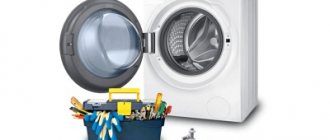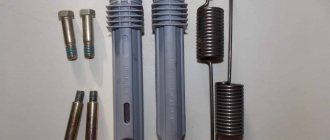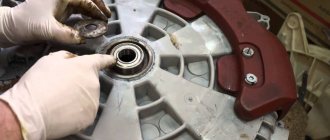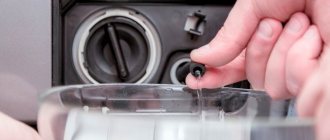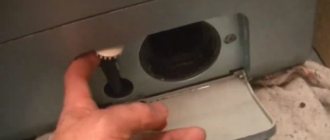There is now a washing machine not only in every city apartment, but also in rural houses. Units from well-known foreign brands have been operating for decades and are distinguished by excellent quality indicators. This cannot be said about the products of some domestic companies and products from China. There is no need to list the reasons for marriage; they are standard and, unfortunately, have not changed for years.
If a city resident’s washing machine stops working, there is no problem; at any moment he will call a technician and he will quickly fix all the problems. In the most difficult cases, he will take the machine to a specialized workshop and, after a few days, deliver it back already repaired.
But what to do in a distant village where there is no such opportunity? There is only one way out - try to fix the problem yourself. Moreover, replacing the heating element is the simplest type of repair work.
Replacing heating element in a washing machine
Causes of heating element failure
Not a single manufacturer of washing machines produces all the components themselves; a significant part of them is made at related enterprises to order. As a result, the risks of supplying low-quality goods increase. Responsible manufacturers send their representatives to suppliers to monitor the entire process and check products on site, and hacks buy what is cheaper. As a result, the heating elements fail. This is the main cause of breakdowns. But there are also objective factors related to operating conditions.
- The heating element coil or control sensor has burned out. In villages, the voltage in the network often jumps; due to strong winds, wires on overhead power lines may overlap. The result is that the voltage instead of 220 V is 380 V. Either the heating element, or the automation, or all together burns out.
One of the causes of failure may be a burnt-out spiral - Poor water quality. Very often, water has a high concentration of calcium; at high temperatures it hardens and settles on the surface of the heating element. Calcium greatly impairs heat transfer, which significantly reduces heating efficiency. But these are not all the problems created by calcium solids. They provoke a significant increase in the heating temperature of the nichrome spiral; it is not designed for such modes and quickly burns out. The high temperature of the heating coil causes the metal casing to overheat - it also burns out.
Calcium deposits are most often the cause of heating element failure
How to diagnose and solve the problem yourself?
Let's take a closer look at how to diagnose possible reasons for the lack of necessary water heating and ways to solve the problem.
Incorrect washing mode selected
The Samsung washing machine is equipped with a large number of different washing programs, each of which provides a specific water heating.
Therefore, before calling a specialist, it would be a good idea to make sure for yourself that the specified washing program generally provides for heating the water.
Incorrect connection
There are situations when, due to connection errors, the washing machine constantly fills and drains water. The result of such active circulation is that the water does not have time to heat up to the required temperature.
You can fix the problem as follows:
- First, check the drain hose (if the problem is in the connection, the hose will be constantly warm);
- reconnect the drain hose and, if necessary, install a check valve in the drain system.
Water drain hoses must be positioned strictly according to the manufacturer's instructions.
Temperature sensor (thermostat) faulty
The small white cylinder located in the body of the electric heater is a temperature sensor. It is he who is responsible for the timely switching on and off of the heating element. Over time, scale settles on the walls of the sensor and disables it, as a result of which the water in the washing machine stops heating.
To make sure that the cause of the problem is a faulty sensor, you need to test it with a multimeter:
- Disconnect the wiring, carefully remove the heating element with the sensor and carefully, trying not to deform the rubber seal, remove the thermostat.
- Use a multimeter to measure the resistance.
- Place the sensor in hot water and measure again with a multimeter.
- If there is no difference in resistance values, the sensor requires replacement.
Replacing a temperature sensor is simple: just remove the old element and install a new one in its place. If necessary (if the rubber seal was damaged during dismantling), the sensor mounting socket is coated with sealant or glue.
The heating element has burnt out and the heating element needs to be replaced
A tubular electric heater (TEH) becomes coated with hard water and low-quality detergents and overheats and burns out. As a result, the Samsung washing machine does not heat the water.
A multimeter will help you diagnose the heating element:
- Disconnect the heating element wiring. To do this, unscrew the central nut and, without removing it from the stud, press it in by lightly tapping it inward. After squeezing out the rubber gasket, the heating element is removed from the tank.
- The multimeter is switched to ohmmeter mode and the probes are applied to the heater contacts. If the resistance readings do not exceed “1”, the heating element has burned out.
Replacing a faulty element is simple: just insert the new heating element all the way into the tank, tighten the central nut, and connect the wires.
The final stage of any repair is inspection. To do this, run the machine on any program.
How to tell if the heating element is not working
Due to the fact that it is impossible to open the tank during washing, you should find out about a breakdown of the heating element by indirect signs.
You can roughly calculate the time for draining dirty water into the sewer before rinsing and at this moment touch the surface of the hose. If it is warm, everything is normal, if it is cold, then the heater needs to be changed. But not everyone has the opportunity to do this. By what other signs can you notice a breakdown of the heating element?
- The quality of washing has deteriorated sharply. Moreover, it does not increase when replacing the washing powder used and increasing the heating temperature on the control panel.
- Electrical energy consumption during washing has been significantly reduced. We must remember that the machine uses at least 80% of all energy to heat water.
- The washing machine turns off on its own or the circuit breakers of the protective electrical fittings are triggered. Such situations are observed when filling the machine with water. If this happens to you, immediately disconnect the device from the power supply and do not use it until repaired.
If the quality of the wash has sharply deteriorated, you need to check whether the heating element is working
Important. Unfortunately, most domestic houses and apartments of old projects do not have grounding, which significantly increases the risk of injury. At the first sign of problems with short circuits, you should turn off the electrical equipment as quickly as possible and call a professional electrician, or fix the problem yourself. But for this you need to have special tools and devices, and know the requirements of the PUE.
Washing machine heating element device
Malfunction prevention
To prevent the formation of scale, and therefore the cause of combustion of the heating element, preventive maintenance should be carried out periodically:
- 100 grams of citric acid should be poured into the detergent (powder) tray. You need to pour it into the main compartment;
- After closing the container, make sure that there are no things in the drum and set the washing mode for an hour and a half at a temperature of at least 90 degrees;
- After finishing washing, wipe the drum and tray dry.
After carrying out such preventive washing, it is recommended to use citric acid no earlier than 4 months later. At the same time, the heating element will most likely remain in perfect order during this time and will not burn out.
Algorithm of actions
We will give detailed instructions for checking and replacing the heating element a little lower, but now we suggest you familiarize yourself with the universal algorithm of actions, regardless of the specific brand of washing machine.
Table. Procedure for replacing the heating element.
| Repair stage | Brief description of actions |
| Manufacturers install heating elements in various places. Getting to some is not difficult, but in other cases you have to disassemble almost half of the unit to do this. This is done deliberately; using this method, manufacturers force consumers to repair machines only in specialized workshops. How to find out where the heating element is located? Move the machine aside and inspect the back wall of the case. If there is a large metal plug on it, then it is easy to remove the heater - remove the cover and gain access to the fixing screws. If the case is solid, you will have to remove the entire front panel. It will take much more time to dismantle the elements than it takes to replace the heating element. |
| Before starting work, be sure to unplug the washing machine from the socket. Unscrew all elements of the washing machine body that prevent access to the heater. Inspect the device carefully. If you don't trust your memory, it is recommended to take a photo of it. Some types of heating elements may contain temperature sensors; this complicates the replacement algorithm and increases the cost of repairs. |
| Additional performance check and installation of the heater | The heating element can fail for several reasons; you must make sure that it is faulty. We will explain how this is done a little further in this article. Installation of elements is carried out in reverse order. Pay attention to the condition of the rubber gasket; it may be damaged when removed. If you have such a situation, then you need to change it too. It’s better to do this right away than to discover leaks under the washing machine during operation. They can provoke very unpleasant consequences. |
Before starting work, it is recommended to familiarize yourself with the technology for checking the serviceability of the heating device.
Possible difficulties
The main problem that may arise when repairing a Samsung washing machine is the inconvenient location of the heating element and temperature sensor.
Unlike other brands, in a Samsung washing machine the heating element is located on the front wall, and in order to get to it, you need to carry out a number of manipulations:
- Turn off the power to the washing machine, pull it away from the wall, and drain the remaining water from the tank.
- Remove the powder tray and unscrew the two bolts at the back to remove the top cover.
- Carefully unscrew the fastening screws on the sides and remove the control panel (do not disconnect the wiring).
- Having bent the hatch seals, use a screwdriver to remove the clamp and tuck the rubber into the drum.
- Unscrew the fixing bolts of the UBL (hatch blocking device) and disconnect the wiring.
- Unscrew the bolts around the perimeter and remove the front cover. The heating element leads are located directly under the tank.
There are wires coming from the control panel inside
When dismantling a household appliance, it is very important not to damage them.
Rules for checking heating element
You can check the heating element without removing it from the tank, which greatly simplifies and speeds up repair work. If it turns out that it is completely serviceable, then the problem is with the control electronics, and its repair requires special technical education. Without such knowledge, it is better not to touch the control system. The test is done with a tester or other electrical device that allows you to measure resistance and current.
The serviceability of the heating element is controlled by three parameters.
- To break a nichrome spiral. This is the most common reason for heating element failure: for some reason the coil burns out and no current passes through it. This malfunction is checked by testing the element; for this, the tester leads are connected to two terminals of the spiral. The measurement switch is set to the “Resistance” position. If the arrow of the device sharply deviates towards o, then the spiral has burned out. Before dialing, check the functionality of the device - close the two outputs, the resistance arrow should suddenly move to zero.
Using a multimeter you can determine the break in the spiral - For breakdown of the hull. This is a very dangerous malfunction, especially for those users of washing machines whose electrical wiring in their house or apartment is not grounded. The current enters the unit body, causing serious damage. By the way, many have already encountered small breakdowns in the body. If you easily run the back of your hand over the metal parts of such devices, you will feel a tingling sensation. It indicates that the entire unit is under voltage, although it is still low and does not cause harm to the body. How to check for a breakdown on the housing? Connect one output of the device to the heater terminal, and the second to the metal part of the housing. If the arrow is at zero, everything is fine; if it deviates, then the element must be changed. During testing, set the device switch to 200 MΩ. It is very important to repeat the test on a heated heating element. Connect power to it for a few seconds, disconnect and repeat the test. Very often, a breakdown is detected in a heated state. This is due to the expansion of the internal fillers of the heating element; such a heater must be changed.
This is how hull breakdown is determined - Power check. It is not considered mandatory, but you can do it for a full guarantee. Find out how much current should flow through the spiral. To do this, its power must be divided by voltage. For example, for a 1900 W heating element, the current is 1900:220 = 8A. Switch the tester to AC ammeter mode and connect all elements in series to the power source. If the arrow points to 8 A, then everything is normal. If the current strength has decreased, then the heater is critically worn. It still works, but we need to prepare for a replacement. In order not to disassemble the machine again in a few months, it is better to immediately install a new one.
Checking the power of the heating element
Diagnostics
If you notice that your SMA has stopped heating water, then you should carry out express diagnostics, which will help you find out the technical condition of those elements that may interfere with heating the water. In this case, it is necessary to carry out a visual inspection and other actions aimed at identifying the source of the problem.
- External inspection of the condition of the internal wiring - it is possible that mice have chewed it. In most cases, such defects can be noticed with the naked eye, but it happens that the defect is not visible. In this case, you should check the voltage in the wiring that goes to the heating element - in operating condition, the closed relay pair rings.
- Inspect the heating element for scale detection.
- Checking the functionality of the heating element using a special measuring device - a multimeter. To do this, you need to measure the resistance of the device, after which the heating element is heated and the resistance is measured again. If the final parameters are almost identical, then this directly indicates that the element has burned out. In good condition, the resistance is about 25–40 Ohms; if these parameters are different, it means the heating element requires replacement.
Step-by-step instructions for replacing the heating element
We will consider a simple option - the heating element is located behind the drum.
Step 1 . Drain any remaining water from the drum. To do this, open the bottom cover on the front panel of the case and remove the plug. Place a low container to collect water, otherwise it will spill on the floor. To drain completely, it is recommended to tilt the washing machine slightly and hold it in this position for several seconds until the liquid drains.
There should be no water left in the machine
Important. Do not allow sudden movements of the washing machine; it has heavy balancers that can damage the body. Weights dampen vibrations during spinning of laundry.
Step 2 . Place the machine in a free space and provide access to the rear. Unscrew the shield; it is secured with four screws. Remove the part and place it near the wall. Do not throw anything under your feet; all elements of the washing machine, electrical appliances and tools must be in order and in their places.
Remove the back cover to get to the heating element
Step 3 . Find the heating element, it is screwed to the bottom of the drum. It has three terminals: phase, neutral and ground. Some models have temperature sensors on the body of the heating element; handle them very carefully, they do not respond well to impact forces.
The heating element is usually located below the drum
Step 4 . Remove the phase and neutral terminals, unscrew the grounding fixing nut, and remove the contacts connected to it from the screw.
Carefully remove the contacts and unscrew the nut
Practical advice. Before further dismantling, we recommend checking the functionality of the heater. We described above how this is done.
If the heating element is working properly, then there is no point in disassembling anything further; the cause of the breakdown is different. If you have enough technical knowledge, then you need to look for it in the control and automation system. If you have no experience, call a specialist. To make it easier to make the right decision, let us inform you that the cost of the control unit can be up to 50% of the price of the washing machine. And unqualified intervention in its work in most cases causes complete failure with the impossibility of further recovery. If the heating element is confirmed to be faulty, continue disassembling the machine.
You can check the serviceability of the heating element without removing it from the machine body
Step 5 . Unscrew the locknut of the grounding screw, but not all the way, but to the length of the thread. This is done so that when tapping on the nut the thread does not jam. You need to knock until it sinks a little, thus weakening the expansion of the rubber gasket. The fact is that to seal the heating element, an internal plate is used, which, when the nut is tightened, is pressed against the rubber gasket and expands it.
With light blows of a screwdriver, loosen the fixation of the heating element.
Step 6 . Using a screwdriver, carefully pry the heater body around the perimeter and slowly tear it off. The rubber has stuck a little, don’t rush, don’t deform the seats.
To pull out the heating element, you need to pry it slightly with a screwdriver
Step 7 . Buy a new part from the store. Professionals strongly recommend taking an old heating element with you, this is the only way to guarantee that you won’t make a mistake with your choice. The fact is that manufacturers produce a new heater for each model; it may differ by only a few millimeters in length or width. This gives the right to assign a new series to the washing machine and, accordingly, sell it at a new price. And heating elements are no longer interchangeable.
The new heating element must have identical dimensions
Step 8 . Clean the place where the heater is installed from calcium, there will be a lot of it there. Use any available items, check the quality with a flashlight.
The heating element installation site must be thoroughly cleaned
Step 9 . Inspect the condition of the sealing rubber seat and, if necessary, remove carbon deposits from the surfaces.
The seal seat must also be clean.
Step 10 . Loosen the grounding nut and insert the heating element into place. Make sure it occupies a special niche.
Insert a new heating element into the housing
Step 11 . Tighten the nut and connect all wires.
Connect everything in reverse order
Pour some water into the drum and turn on the heat for a few seconds, then turn off the machine. If the heating element is warm and there are no drips, great, screw on the remaining parts and place the unit at the place of use.
Replacing heating element in front position
Video - Replacing heating element in a washing machine
The process of replacing heating elements in different washing machines has significant differences. Now you understand what to do in each specific case, follow the instructions and carry out work only taking into account the requirements of the PUE. If you have time left, you can help your wife clean the oven; this also requires special skills. To make your work easier, we recommend reading an article about this on our website. It will give you the opportunity to avoid making annoying mistakes and save a lot of time.
Expert advice
- If you don’t want to get tangled up in bolts, nuts, and parts, don’t throw anything at your feet. Place the ingredients carefully. You can take photos with your phone before each stage, and at the end, while assembling, check the photo. This will help you do everything right.
- Some heating elements have temperature sensors. They react poorly to impacts, even weak ones, so handle the parts with extreme care.
- Do not use sharp objects when cleaning the internal parts, but it is useful to soak the heating element itself in a solution of citric acid.
There is already a washing machine in almost every apartment or house. If previously such equipment was a sign of wealth, now its absence causes bewilderment: how can a housewife do without such a necessary thing?
As a rule, a washing machine breakdown happens at the wrong time. Read our articles on how to identify faults and repair the pump, drum, pump, drain and pressure switch yourself, as well as replace bearings.
In order for the machine to last as long as possible, it is worth studying the basic rules of care and repair. After all, it is not always possible to find a specialized workshop nearby with a good, conscientious craftsman. Replacing a heating element is one of the simplest repairs: you can handle everything yourself.
How to check if a washing machine is heating water
A situation may occur when the washing unit has fully completed all stages of washing, but the laundry was poorly washed, although the same detergent was used. One of the reasons may be non-compliance with the temperature regime. In other words, the machine washed clothes in cold water. In this case, it is worth checking whether the water entering the washing drum is heating up.
To do this, you need to select one of the washing modes, which involves heating the water to a temperature of 50-60*C and 20 - 30 minutes after it starts, touch the glass of the loading hatch. For top-loading machines, place your palm on the top cover. If these elements are warm, the water heats up; if they are cold, the washing unit is faulty. After finishing washing, you should identify the causes of the malfunction and eliminate the malfunction. Further use of the washing machine will not only not lead to the desired washing result, but may also render it completely unusable.
Self-diagnosis and troubleshooting
Initial diagnostics can be carried out without calling a specialist - to determine what the reason is, check the details that we described above. Both visual and technical inspection are required.
Step-by-step instruction:
- Inspect the sensor that monitors the water level in the tank. The pressure switch, or rather its tube, fills with hair and small debris. You can determine the blockage visually by simply looking inside the tube. To get to the hose, you will need to remove the top or side panel of the machine.
- Checking the wires of parts. Most often, the wiring coming from the heating element breaks, but to be sure, inspect all the wires inside the washing machine. Perhaps some of them are frayed, they need to be soldered and insulated with electrical tape.
- Checking and inspection of the heating element. The heating element is checked with a special device - a multimeter. First, they measure its initial resistance without connecting it to the network, then heat it up, measure and compare the resulting numbers. If the indicators are practically the same, the part is faulty. It also happens that an intact and undamaged heating element is preserved under a layer of scale. Read more in our article:
- Thermostat diagnostics. If the heating element, pressure switch and wiring are normal, but the water is still heating up, check the temperature sensor with a multimeter (in modern machines, a thermistor). Typically, the sensor looks like a small metal cylinder with wires connected to it.
Diagnostics
To recognize the presence of a malfunction, it is not necessary to disassemble the washing machine and use a multimeter. The following may indicate problems:
- the washing machine fills with water, but finishes the wash very quickly and after 5-7 minutes turns off completely;
- When washing, the water does not heat up to the level specified by the program;
- almost immediately after the machine turns on, the traffic jams in the room are knocked out;
- the quality of washing is significantly reduced;
- the body produces an electric shock when touched;
- There is an unpleasant burning smell in the room when using the device.
These signs indicate that the device needs inspection and subsequent repair.
If you have a multimeter at hand, then it will not be superfluous to check the performance of the dielectric and the spiral. This can be done by checking the resistance of the element using the formula:
R = U² / P
The resistance of the heating element will be equal to the square of the voltage that goes to it, which should be divided by the power of the device itself. That is, for example, the voltage that goes to the heater is 220 volts, as in a regular outlet. And the power of the heating element is 2000 Watt. The result is just over 24 ohms, which would be normal resistance. If the heating element is working properly, the tester will show this value.
To measure resistance, do the following:
- switch the tester to resistance measurement mode by setting the switch to 200 ohms;
- touch the multimeter probes to the heater terminals;
- view the obtained value on the device display.
If you need to check the dielectric of the heating element, you should do the following:
- switch the tester to the dialing mode by setting the switch to the “Buzzer” mode;
- touch the heating element terminal with one probe;
- Place the second probe against the grounded terminal or body of the heating element.
If the device starts to squeak, the dielectric passes current to the device body - this means that the heating element is broken. And if there is no sound, then the heating element is working and the breakdown should be looked for elsewhere.
